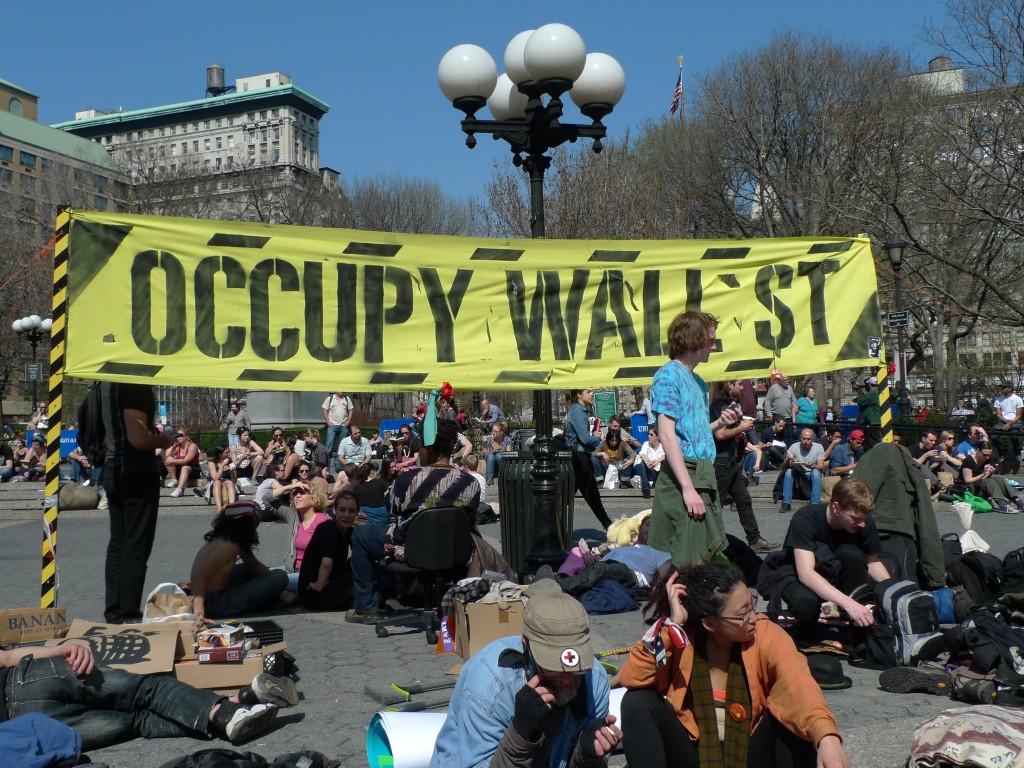Yesterday I had the privilege of presenting at the first Open Forum at Union Square. Open Forum was a daily event at Liberty Plaza during the encampment in which an invited presenter would talk at 6.00pm. It was interestingly different to do it at Union Square and to think about the ways in which learning outside and outside the official realms of learning have changed in this intense movement time.
When you presented at Liberty, you usually did it on the stairs on the East side of the Plaza, not least because the drummers often made the West side a talk-free zone. The unusual architecture of this space, designed to be overlooked or at best passed through on your way somewhere else, gave it an oddly private feel. When you stood on the steps and looked down at the group, it felt intimate, whether it was a few dozen as it was when I did it, or when it required two relays on the human mike as it did when Angela Davis was there. The policing came to reinforce that sense of separation, as cops would require people at street level to move on, meaning that if you wanted to be part of OWS you had to step into the Plaza.
Union Square is very different. It’s flat and open but also well-used as a venue in its own right. Yesterday there were a group calling for Free Tibet and an assembly of mostly African-American young people using a subcultural dress code that was very striking but not legible to me. So you present in a circle that is constantly changing as people come and go, stay for ten minutes and leave, as well as those who intended to be there. You’re open to the city in a different way, meaning that I could use a nearby Bank of America tower as a prop but also that the inevitable police sirens very much intrude. In short, it’s the difference between Zuccotti/Liberty as a proscenium space and Union Square as a theatre in the round.
As much as I regret Liberty Plaza and loved being back there on March 17, there’s also a sense in which Union Square feels more grown up. Liberty was like our own private space, literally and metaphorically our bedroom, whereas Union is downstairs, a public space. There’s also a new openness. We were talking about student debt. Two people present were working on projects about debt. One young man, who didn’t tell me his name, did tell me that he was “six figures” in debt for his Columbia degree. That would not have happened last September.
It’s still absurdly policed, so that we were told that you can’t put cardboard on the pavement now. Some Occupiers are now sleeping on the streets outside banks and have made a sign detailing how in the case of Metropolitan v. Safir, the U.S. District Court covering New York City ruled that
the First Amendment of the United States Constitution does not allow the City to prevent an orderly political protest from using public sleeping as a means of symbolic expression.
It has, at least for the time being, stymied the cops.
There is a dynamic to being outside in this hyper-policed city. It’s given expression by the Trayvon Martin case. If Trayvon had been in a car, Zimmerman would never have attacked him. Just as a woman in public in the nineteenth century was literally called a “street walker,” so is anyone on the street automatically a criminal suspect to the policing mentality. We are supposed to stay in our gated communities, in our buildings, or in our cars and not be outside.
In the Politics and Visual Culture Working Group, we’ve noticed this as well. When our meetings are outside, whether in a park or as part of an action, there’s a very different and more vibrant dynamic then when we are in an NYU classroom. Just to reinforce this, NYU’s new expansion plan calls for 70,000 sq. ft. of classroom space–underground, in what is now a parking garage, with access only from a security-controlled building. The institution tells its debtors to park their minds and pay their bills.
It’s going to be warm this weekend–get outside!

